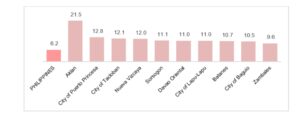Department of Science and Technology-Food and Nutrition Research Institute (DOST-FNRI) on Monday November 15 released the 2021 Expanded National Nutrition Survey (ENNS) which revealed that obesity rates among children aged 0 to 5 and 5 to 10 at 3.9 percent and 14 percent, respectively. Also, at the same survey, the trend was seen also among older people, with one in every 10 adolescents and four out of 10 adults were either overweight or obese.
It further said that 10% of adults aged 20 to 59 were obese, while among the elderly aged 60 and above, 6.2% are obese and 11.8 have chronic energy deficiency.
In another aspect of the survey, it also said that one in every four (1 out 4) Filipino children under 5 years old is experiencing stunted growth.
The ENNS, which conducted the survey between July 2021 and June 2022 in 37 provinces and cities in the country with respondents of 141,189 Pinoys, is an initiative to quantify Filipinos’ health and food security conditions at the height of the pandemic. The data will be helpful to the government to craft policies and programs toward a full recovery from the pandemic.
The survey measured the weight and height of household members, their blood pressure, sugar and lipid profiles, and other health indicators like the vitamin A, iodine, and iron status of selected population groups, dietary intake of all household members, breastfeeding, and smoking and drinking habits.
The survey revealed that high obesity rates caused the Philippines to miss its target of no increase or reduced obesity prevalence under the Philippine Plan of Action for Nutrition 2017-2022. It also said that three in every 10 households in the Philippines were unable to meet their nutritional requirements as unemployment and inflation made it difficult for poor Filipinos to afford basic commodities.
The World Health Organization (WHO) defines obesity or being overweight as the extreme or unusual fat accumulation in the body. This condition is described using body mass index (BMI), defined as a person’s weight in kilograms divided by the square of their height in meters (kg/m2). The WHO said that obesity is caused by the imbalance of energy in the body between the calories consumed and the calories burned up, or too much eating and drinking without enough physical activity.
In adults for example, a BMI equal to or greater than 25 is considered overweight; obesity is a BMI greater than or equal to 30. For children, a BMI that is one or two standards above the average measurement by the WHO Child Growth Standards is obese.
Stunting in children or being shorter than their age is classified as a “high public health significance” under WHO standards, as the survey found that 26.7% of Filipino children aged 0 to 5 were stunted.
Moreover, the ENNS data from January 2018 to February 2019 said that 37.2% of adults were obese. For adolescents, 11.6% were obese in 2018, an increase from 9.2% in 2015. At least 5.2 children aged 0 to 5 were “overweight for height” in 2018.
The survey also said that one in every 10 preschool-aged children is underweight while 5.5 percent of children are wasting or extremely thin.
it also noted that most preschoolers were also not getting enough energy and micronutrients they need to grow. More than half of the stunted children came from the poorest and poor households in the country, affecting girls more than boys.
Only one in 10 children between 6 and 23 months met the minimum acceptable diet, indicating “poor quality and quantity of complementary foods,” the survey said.
DOST-FNRI senior science research specialist Charina Javier said that this was in part because Filipinos were sedentary during the pandemic, as lockdowns barred people from going out. This was supported by another survey which revealed that four in every 10 Filipino adults were not physically active enough.
The DOST-FNRI survey also painted a dismal picture of Filipinos’ food security or access to food. It found that more than a third (1/3) of Filipino households were moderately or severely food insecure, meaning, they are unable to eat as much or meet their nutritional requirements because they have no food. This trend was more evident mostly in poor, male-led households with more than five members. Many of these households subsisted by either borrowing food or money from their family members to cope with their daily basic needs.
Meanwhile, Ischemic heart disease was the top main cause of death in the Philippines last year, with a reported 125,913 deaths from January to November 2021, according to data from the Philippine Statistics Authority (PSA). Cerebrovascular disease was the second main cause of death from January to November 2021 at a total of 68,180 deaths, the PSA also noted.
The WHO said ischemic heart disease, which is also called coronary artery or heart disease, is caused by narrowed arteries that obstruct blood and oxygen from reaching the heart muscle, causing a heart attack. Cerebrovascular disease is a condition that affects the blood flow in the brain that may cause narrowed blood vessels, clots, blockage, and hemorrhage.





More Stories
Healthcare heroes celebrated as PH commemorates ‘Day of Valor’; multi-year healthcare waste management project launched
OCD seeks to enhance conduct of NSED; set to simulate various scenario exercises
6 months suspension meted to 139 NFA officials and employees